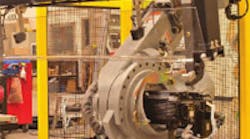Manufacturers face a variety of machine guarding challenges: old equipment vs. new equipment; point-of-operation vs. mechanical power transmission; highly automated, multiple-purpose machines vs. manual, single-purpose machines; continuous utilization vs. infrequent use; etc. The simplest approach often is the best. In the first article of a two-part series about the do’s and don’ts of fixed and moveable guards, we’ll examine the use of fixed guards.
OSHA’s general regulatory requirements for fixed and moveable guards are discussed in 1910 Subpart O – Machinery and Machine Guarding. More detailed and contemporary requirements can be found in ANSI
B11.19-2010 – Performance Criteria for Safeguarding. Machine-specific guarding requirements can be found in individual ANSI B11 series safety standards.
OSHA requirements provide enforceable baseline requirements. But serious practitioners seeking optimal results also consider and comply with the most relevant consensus standards. ANSI B11.19-2010 provides detailed guidance about how to effectively and safely interface safety requirements with current design technology and theory. Consensus standards also can be enforced by OSHA and compliance with consensus standards, such as ANSI B11.19-2010, can help protect businesses from lawsuits in the event that an incident occurs.
Machine guard designers inherently want the simplest, most cost-effective approach to address the types of challenges and needs of end users. Like many current safety standards, ANSI B11.19-2010 relies upon formal risk assessments to help guide users to the best solutions. Properly conducted risk assessments can provide the tools and logic needed to develop and deploy solutions that satisfy safety, quality and productivity needs.
If the risk assessment determines that workers never or infrequently (e.g., weekly or less often) require access to the hazard zone of a piece of equipment, fixed guards should be a first consideration. Properly designed and installed fixed guards can provide comprehensive protection by utilizing barriers to isolate workers from potential hazards.
Isolation means that workers cannot defeat or otherwise circumvent the protection afforded by the fixed guard by reaching the hazard zone(s) with any part of their bodies. Effective fixed guards should be absolute in their protection – workers should not be able to reach around, under, through or over (AUTO) fixed guards. Properly designed, installed and maintained fixed guards offer the added advantages of low cost, compact design and high reliability.
Fixed guards often are used to protect workers from the hazards associated with flywheels, fan blades, screw conveyors and power transmission equipment. Fixed guards also can be used to protect other points of access to machine tools (e.g., side and rear openings to mechanical power presses, drill presses and machining centers).
While fixed guards might appear to be a panacea, they are not without their risks, even when the application is appropriate. Deployment of appropriate protection methodologies requires specialized knowledge and perfect execution.
Worker injuries can occur on equipment that relies on fixed guards when:
Guards don’t meet “safe mounting distance” requirements. The guards must be positioned far enough away from the hazard zone to preclude possibilities of worker encroachment into the hazard zone (Figure 1). See ANSI B11.19; ANSI/RIA R15.06; OSHA 1910.217 Table O-10; CSA Z423; and/or ISO 13857, Table 5.
Materials used in fabrication of fixed guards are not of adequate strength or durability. Barrier guard materials that can break, bend or distort are not acceptable. Similarly, materials that deteriorate in the presence of airborne swarf, ultraviolet radiation, temperature extremes, oils, coolants, solvents, cleaners or other environmental contaminants/agents can compromise the intended protection of fixed guards. Polycarbonates and other transparent materials carefully must be evaluated and maintained. Material specification and selection should be based on risk assessment findings and include consideration of operational conditions such as vibration and impact.
Improper fasteners are used to secure guards. Not only must the fasteners be strong enough for the application, but they also must require special tools for removal. This latter feature – which automatically precludes the use of wing nuts, standard screws (slotted or Phillips), latches, hasps, magnets and hooks and eyes – is designed to prevent unauthorized removal, circumvention or adjustment of fixed guards.
The utilization of uncommon fasteners is recommended. The European Machinery Directive requires additional layers of safety. The Machinery Directive requires fastener systems to remain attached to the guards or to the machinery when the guards are removed, and, when possible, that the guards are incapable of remaining in place without their fasteners. These requirements deserve full consideration for all fixed guarding applications, regardless of the geographic location of the business.
Guards are removed and not replaced. This vulnerability can be created following maintenance, installation or repair. Since lockout presumably is required when performing these functions, machine-specific lockout procedures should require proper replacement of fixed guards prior to removing locks. Verification of compliance can be achieved through periodic inspections.
Machine/equipment is moved, retooled, modified, repurposed or otherwise changed (e.g., new operating methods, new staffing strategy). A robust change management procedure is needed to identify and safely control these variables.
Visibility is hampered.When possible, worker visibility of the production process cannot be obstructed by machine guards or devices. Unhampered visibility can help operators identify malfunctions, misalignments and other potential hazards. It is important to select proper materials (e.g., transparent, mesh or expanded metal barriers) and to assure that they properly are contrasted in order to accommodate adequate visibility. If mesh or expanded metal is chosen, ANSI B11.19-2010 specifies that the color of the barrier material should be darker than the area observed to enhance visibility.
The next article in this two-part series will provide a similar analysis of moveable guards.
John Peabody is the vice president of major accounts for Omron STI. He is a 20-year company veteran and holds a bachelor of science degree. Peabody and his team help companies with machine safety training, machine safety assessments and installation options of safeguards and devices to help them meet their machine safeguarding goals.
